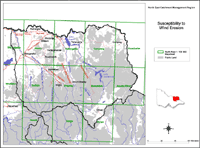Susceptibility to wind erosion
| Wind erosion is the movement of soil particles by wind. It occurs when the lift forces of the wind exceed the gravity and cohesion of the soil grains at the surface. Susceptibility of land to wind erosion is determined by taking into account the inherent features of the soil, the climate and position in landscape. The erodibility of the topsoil is a major factor, but structure, texture, stoniness and organic matter are all significant. Land use and management may have a major influence on the degree of deterioration, particularly if dry soils are exposed when erosive winds are likely to occur. Wind erosion is likely to reduce the organic matter and nutrients available in the topsoil, while the reduction in topsoil depth also leads to reduced water infiltration causing increased runoff and a fall in productivity. |
The loose sandy topsoils on granitic parent materials are highly susceptible, while the open plains with fine sandy loam topsoils, and the lower slopes of the drier granitic areas have moderate susceptibilities.
To view the information PDF requires the use of a PDF reader. This can be installed for free from the Adobe website (external link).
(PDF 587KB)
The land characteristics and management factors involved in wind erosion are described in Table 8.
Table 8 Land characteristics and management factors involved in wind erosion
| Processes | Land features affecting processes | Factors affected by land characteristics | Management factors that modify land characteristics |
| Wind erosion occurs when the force due to wind is sufficient to overcome the cohesion and weight of the soil particles and to allow their movement |
|
| All aspects of the vegetation are affected by selection of species and control of biomass by practices such as grazing, trampling, harvesting, burning, cultivating, clearing, trafficking, fertilising |
Processes involved are: |
|
| |
|
|
| |
|
|
| Retention or construction of wind- breaks, cloddy cultivation and ridging affect microrelief |
|
|
| Soil disturbances such as trampling cultivating affect aggregate stability Any practices affecting biomass alter the organic matter content of the topsoil |



